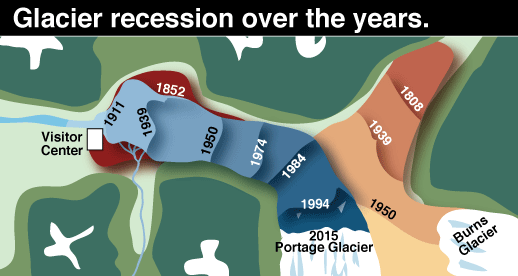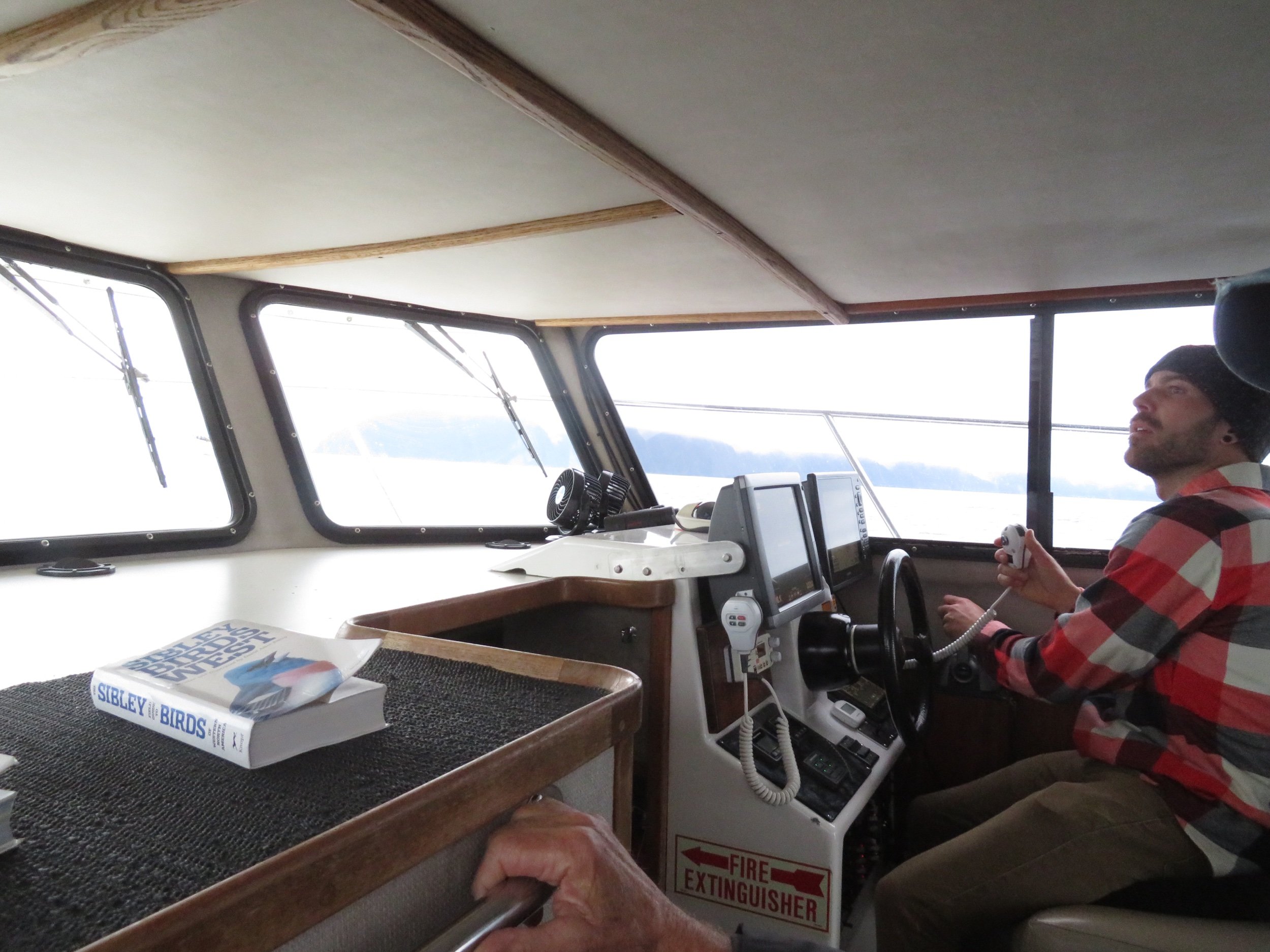Welcome to the Kenai Peninsula -2
/Portage Valley, Seward and Kenai Fjords National Park
Continuing down the eastern Kenai Peninsula, check the map below to follow our progress.
Still at the Willawaw Campground, we woke to NO RAIN… Hallelujah! It was still cold and raw, but not wet… a definite improvement. We had yet to walk the Trail of Blue Ice and today was the day. The 3-mile round trip paved trail with decked sections over the bogs, was easy walking and very pleasant. We kept thinking we’d see a moose or a bear, but we never did. As we passed by the Freestone Ponds, we did spot a female Barrow’s Goldeneye. Click on the thumbnail to enlarge the image.
At the end of the trail, we crossed the parking lot to the Begich-Boggs Visitor Center for a look at the exhibits and to view a video about glaciers and the changes that have taken place in glaciation in the past century.
Nearly 40 years I stood here on the edge of the Portage Glacier and now it has receded so much it’s only visible by taking a boat tour on Portage Lake.
There are six glaciers in the near vicinity, hence the Trail of the Blue Ice. We did get a glimpse of the Byron Glacier.
By the way, the Begich-Boggs VC is named for Nick Begich, Alaska Congressman, and Louisiana Congressman and, at the time, Speaker of the House, Hale Boggs, who disappeared in 1972 along with their pilot on a flight en route to Juneau from Anchorage. No sign of them or the plane was ever found.
Hike concluded, we headed south down the Seward Highway once again. Our next stop and destination was Seward, known as the “Gateway to Kenai Fjords National Park”. Situated at the head of Resurrection Bay, another deep water fjord off the Gulf of Alaska, Seward not only has highway access, but the Alaska Railroad’s southern terminus ends there and it’s frequented by major cruises lines as well as the Alaska Marine Highway ferries.
Our first concern was finding a campground. We spotted several National Forest campgrounds as we neared Seward and though they all had sites available, they were all still 20-25 miles from town. Too far. The KOA campground was expensive and still quite a ways out of town. Luckily, Seward has its own city campgrounds and though comparatively expensive for what you get ($40 for dry camping in a potholed, gravel parking lot + $2 reservation fee). The unheated, concrete shower stalls and ablution block shared by hundreds of campers left lots to be desired in the cleanliness and aesthetics categories and the porta-potty alternatives were disgusting.
We noted that the camping sites at Williams Park across the street offered less “amenities” but were $20/night and Blanche fit nicely into a camping spot. We checked to make sure there was no arcane regulation regarding erecting a tent. There wasn’t, so we took a site. Though it too had shared porta-potties, they seemed a bit cleaner, the sites were spacious and the campground was walking distance to town. We were happy. All snugged in, the rain began to fall in earnest once again and it rained throughout the night.
In the drizzle the next morning, we walked into town along a seaside path checking out the Seward Mariners’ Memorial along our path.
Seward is a lovely little coastal town, but we were particularly interested in visiting Kenai Fjords National Park which is headquartered there. Other than Exit Glacier, the only land-accessible glacier in the whole park, the only way to see the national park is via boat or plane. We were adamant that we would not go on a typical commercial cruise with a hundred of our closest non-acquaintances. We decided we’d do some research and come up with an alternative. In the meantime, we visited the Kenai Fjords National Park Visitor Center, right on the main street, picked up a few brochures, checked out the exhibits and continued our exploration of the town. The rain and drizzle continued. Rain has not been not a major deterrent to our travel enjoyment, but it does dampen your spirits after awhile.
We walked along the wet downtown sidewalks avoiding puddles and trying to ignore the incessant drizzle, ducking into shops, checking out potential souvenirs and collecting boat tour brochures.
It seemed the trade-off for fjord tours was more people, lower price versus less people and higher price, a pretty typical business model. After much deliberation back at Blanche, we opted for the less people, higher price, confident we were making the right decision. We booked a “Kenai Fjords National Park Odyssey” tour with Northern Latitude Adventures, a 7.5 hour boat excursion exploring wildlife and glaciers which promised no more than six passengers aboard. Knowing it would be a smaller boat and probably a bumpy ride, we also hunted up some Bonine to ward off seasickness… just in case.
Part of the day was spent doing errands… gas/diesel fill-up, internet at the library, supermarket run and, because the campground showers were so disgusting, we used the clean public showers at the Harbormaster’s offices for $2/7 mins… lots of hot water in a heated building. Lovely!
Tour day dawned overcast, damp, cold and raw but not raining. We walked from the campground to the tour boat office, met Ryan our captain and headed down the docks to the boat, a cabin cruiser, with only two other passengers. After a safety talk and an overview of the day’s route, we headed out of the harbor and into Resurrection Bay. A harbor seal barked as we left the slip.
The water was a bit choppy and the boat hit the waves head-on making for a bumpy ride though we were still in the lee of the bay islands. Once we were in the open waters of the Gulf of Alaska, the chop and intensity of bumps increased along with the decibel level and Ryan increased the throttle even more presumably to get us through the chop and to our destination faster.
We slipped through a narrow passage between two small islets close enough to a rock face to see hundreds of sea stars clinging on as the constant waves lapped over them.
Sea otters with seemingly sleepy looks on their little faces (or were they wry smiles) were unfazed by the boat’s passing. They back-floated lazily rising up and down gracefully with the wave action.
Standing on the back deck as the boat rocked and rolled was a challenge. The cockpit sides were only thigh-high, there were very few handholds, no seats and four people vying for best views. Feet spread apart, we balanced and held on as best we could. It was startlingly cold on deck which kept our visits there short.
Ryan spotted several auklets and puffins in the distance, but with the roll of the boat and the distance, photo ops were limited. These are either auklets or a flotilla of ubiquitous blurry birds.
And a solitary tufted puffin…
As we continued out into the open sea, Ryan indicated he was hoping to provide us with something very special. One of the other passengers was starting to feel seasick, but she opted to continue. In what seemed like a very long time, we finally arrived at the ‘special’ something. Several other boats were already there. We slowed to idle and bobbed up and down as Ryan explained bubble-net feeding.
According to juneauwhalewatch.com , for a few weeks each summer in Southeast Alaska, humpback whales which are usually solitary, gather “together and rapidly circle in an upwardly shrinking spiral. The whales blow bubbles beneath a school of fish, commonly herring teeming the waters in the summertime. The herring are corralled into the “net”, produced by the whales’ precise, fine-scale movements and finely tuned teamwork. Then they efficiently scoop up lunch with their mammoth-sized mouths, gulping thousands of fish at once.”
It lasted only a minute or two and we never knew when or where it would occur again, but the seabirds all knew. When we saw them circling and the water began to roil, we focused on that area and sure enough another bubble-netting event would occur.
It was thrilling to watch as several whales (six or eight maybe), their maws wide open, broke the water’s surface to devour all the fish they’d trapped.
Again and again, the mammoth creatures dove, bubbled and surfaced to eat their prey.
The bobbing and rolling of the boat was maddening and trying to hold on, combined with the distance from the whales and two other people vying for the best rail position on the small deck made photographing the event less than optimal. If I sound like a petulant, frustrated, disappointed child, I was. And as I write this, I still am.
The display ended and the boat headed north about 20 miles up Aialik Bay, a deep fjord that averages about 500’ depth and ends at the Aialik Glacier. A tidewater glacier, one that flows directly into the sea, Aialik is pretty impressive at 1.5 miles wide, 3.5 miles long and 300-400’ high.
Ryan motored to within 1/2 mile or so of the glacier then cut the engines. For about 15 minutes or so, we had the whole place to ourselves. While we ate the sandwiches and chips provided for lunch, we bobbed around watching the glacier calve. On deck afterwards, we listened to the glacier as it groaned, creaked, cracked and sloughed off ice sheets and bergs on a fairly regular basis. Some substantial ice bergs floated nearby and we were reminded that 90% of the berg was still under water. Big bergs!
We began the voyage back to Seward. Some of the mist had cleared and the following seas provided a less bumpy ride. We arrived at the dock about 3:30pm and headed back to Blanche.
Soon after, we had a long conversation about our expectations of group tours and our evaluation of the tour we had just taken. Perhaps our expectations are/were unrealistic. Perhaps, my photographic abilities and equipment were not good enough to capture what I had hoped. The bubble-netting and glacier calving were certainly impressive, but we spent most of the 7.5 hours motoring to and from these events. I’d have liked to have seen more sea otters and puffins en route, for instance. I’d have liked to have been the only people on board. I was hoping for a “WOW” experience and I had to settled for a Gee, that was cool” one. Was it worth $400+/pp for only four passengers and a small boat vs. $230+/pp for a large, 150-passenger commercial vessel plying a similar route?
After much consideration, we came to this conclusion. For what it was, the differential in price for this tour was probably worth it. This begs the question, however, is this type of tour worthwhile for us and probably it wasn’t. We’ve had the opportunity to see hundreds of whales, dolphins, seals, sea lions, penguins, albatross, manatees, dozens of glaciers and so much more, right alongside our own boat. Perhaps, we’re just jaded. That said, at our age, we’ll probably forget and do this again some time.
Next time, a visit to Exit Glacier in Kenai Fjords National Park and then we head to the west coast of the Kenai Peninsula to spend time on the Spit! Come join us!



























